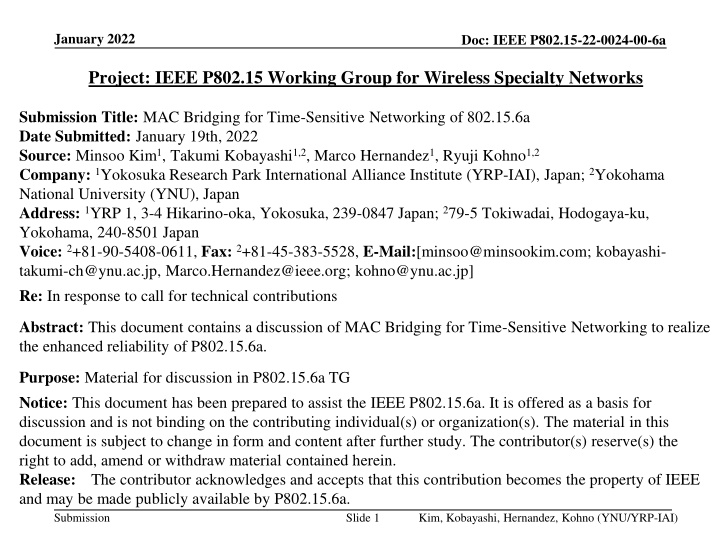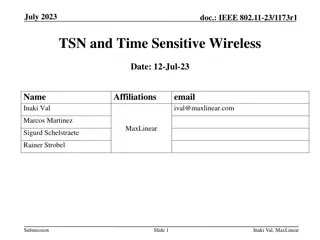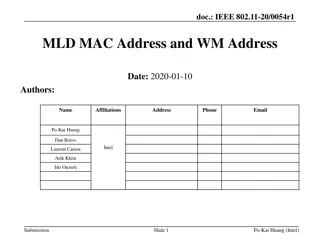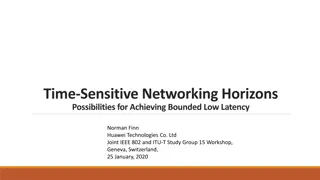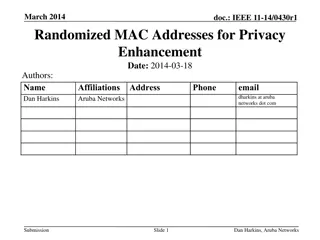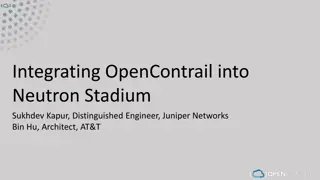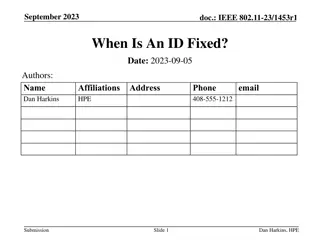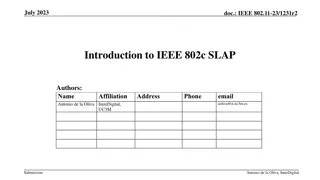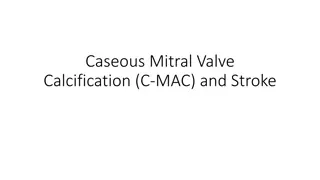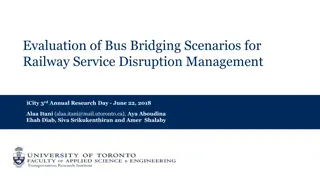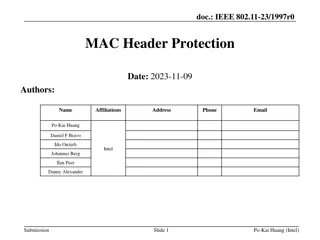MAC Bridging for Time-Sensitive Networking in 802.15.6a
Discussion on implementing MAC bridging for enhanced reliability in IEEE P802.15.6a networks, focusing on Time-Sensitive Networking (TSN) concepts for low latency and reliability in Body Area Networks (BAN). The document addresses the significance of TSN goals for BAN applications like vital signs monitoring, proposing ideas to integrate TSN concepts in wireless networks, particularly in Human-BAN and Vehicle-BAN scenarios.
Download Presentation

Please find below an Image/Link to download the presentation.
The content on the website is provided AS IS for your information and personal use only. It may not be sold, licensed, or shared on other websites without obtaining consent from the author.If you encounter any issues during the download, it is possible that the publisher has removed the file from their server.
You are allowed to download the files provided on this website for personal or commercial use, subject to the condition that they are used lawfully. All files are the property of their respective owners.
The content on the website is provided AS IS for your information and personal use only. It may not be sold, licensed, or shared on other websites without obtaining consent from the author.
E N D
Presentation Transcript
January 2022 Doc: IEEE P802.15-22-0024-00-6a Project: IEEE P802.15 Working Group for Wireless Specialty Networks Submission Title: MAC Bridging for Time-Sensitive Networking of 802.15.6a Date Submitted: January 19th, 2022 Source: Minsoo Kim1, Takumi Kobayashi1,2, Marco Hernandez1, Ryuji Kohno1,2 Company:1Yokosuka Research Park International Alliance Institute (YRP-IAI), Japan; 2Yokohama National University (YNU), Japan Address:1YRP 1, 3-4 Hikarino-oka, Yokosuka, 239-0847 Japan; 279-5 Tokiwadai, Hodogaya-ku, Yokohama, 240-8501 Japan Voice:2+81-90-5408-0611, Fax:2+81-45-383-5528, E-Mail:[minsoo@minsookim.com; kobayashi- takumi-ch@ynu.ac.jp, Marco.Hernandez@ieee.org; kohno@ynu.ac.jp] Re: In response to call for technical contributions Abstract: This document contains a discussion of MAC Bridging for Time-Sensitive Networking to realize the enhanced reliability of P802.15.6a. Purpose: Material for discussion in P802.15.6a TG Notice: This document has been prepared to assist the IEEE P802.15.6a. It is offered as a basis for discussion and is not binding on the contributing individual(s) or organization(s). The material in this document is subject to change in form and content after further study. The contributor(s) reserve(s) the right to add, amend or withdraw material contained herein. Release: The contributor acknowledges and accepts that this contribution becomes the property of IEEE and may be made publicly available by P802.15.6a. Submission Slide 1 Kim, Kobayashi, Hernandez, Kohno (YNU/YRP-IAI)
January 2022 Doc: IEEE P802.15-22-0024-00-6a MAC Bridging for Time-Sensitive Networking of 802.15.6a Minsoo Kim1, Takumi Kobayashi1,2, Marco Hernandez1, Ryuji Kohno1,2 1Yokosuka Research Park International Alliance Institute (YRP-IAI) 2Yokohama National University (YNU) Submission Slide 2 Kim, Kobayashi, Hernandez, Kohno (YNU/YRP-IAI)
January 2022 Doc: IEEE P802.15-22-0024-00-6a Introduction Major use cases of 802.15.6a Body Area Networks (BAN) are for human and vehicle bodies in medical and automotive applications. Some of these applications such as vital signs (e.g. ECG) monitoring are similar to the audio/video traffic in IEEE Std 802.1Q-2018: Bridges and Bridged Networks, in that they are sensitive to transmission latency and packet loss. Hence, goals of Time-Sensitive Networking (TSN) such as low latency and reliability are also important for BAN. We present some potential ideas of using concepts of TSN in wireless networks, especially for Human-BAN and Vehicle-BAN. Submission Slide 3 Kim, Kobayashi, Hernandez, Kohno (YNU/YRP-IAI)
January 2022 Doc: IEEE P802.15-22-0024-00-6a Possible bridging in 802.15.6a BAN WLAN (wireless) LAN (wired) (wireless) Sensor (Talker) Bridge Bridge Bridge BAN WLAN terminal BAN Node Access Point Switch / Router Coordinator BAN Node Sensor (Talker) Server / Nurse station Vital sign monitor Caretaker (Listener) Clinician (Listener) BAN coordinator may relay frames to outer network as a MAC Bridge. End-to-end latency should be kept below permissible value. Submission Slide 5 Kim, Kobayashi, Hernandez, Kohno (YNU/YRP-IAI)
January 2022 Doc: IEEE P802.15-22-0024-00-6a BAN coordinator Like bridges in 802.1 which connects two separate networks, 802.15.6 has coordinators (hubs). A single BAN consists of a coordinator and nodes. The coordinator connects to the nodes of the network to which it belongs. The coordinator can connect to nodes operating on the same PHY as well as nodes operating on different PHYs. The amendment may introduce coordinator-to-coordinator link, allowing a coordinator to connect to other coordinators. To enhance dependability by managing inter-network interference. Unlike wired network, wireless network shares same medium and collision occurs which plays significant role in dependability. Submission Slide 6 Kim, Kobayashi, Hernandez, Kohno (YNU/YRP-IAI)
January 2022 Doc: IEEE P802.15-22-0024-00-6a Interference among BANs or BAN and other systems There would be cases where BANs or BAN and other networks are spatially collapsed. Case 1: BANs, using same frequency bands Case 2: BAN and PAN, using same frequency bands Submission Slide 7 Kim, Kobayashi, Hernandez, Kohno (YNU/YRP-IAI)
January 2022 Doc: IEEE P802.15-22-0024-00-6a Interference among BANs or BAN and other systems Case 3: BAN and other piconets such as cellular network or Wi-Fi, some part of their frequency bands are overlapped. Case 4: Case 1 to 3 combined The concept of 802.1 MAC Bridge can be extended to enhance dependability. The coordinator can manage interference or packet collision among same or different BANs (VBAN and/or HBAN), PANs, and other piconets. Submission Slide 8 Kim, Kobayashi, Hernandez, Kohno (YNU/YRP-IAI)
January 2022 Doc: IEEE P802.15-22-0024-00-6a Two-hop star topology extension Star topology + one hop (current std.) Since there is no Line-of-Sight link between back and front of a human body, as well as a vehicular body Star topology + multiple hops (may be introduced in the amendment) TSN concept may be applicable. Frame Replication and Elimination (802.1CB) When the amendment introduces using more than 2 relay nodes simultaneously. Link Control (802.1Qca) Note: The relaying described in this slide operates on MAC layer, though corresponding 802.1 Stds define routing in the network layer. Submission Slide 9 Kim, Kobayashi, Hernandez, Kohno (YNU/YRP-IAI)
January 2022 Doc: IEEE P802.15-22-0024-00-6a Coordinator to Coordinator Bridging BAN # 1 WLAN LAN Clinician (Listener) Sensor (Talker) Server BAN WLAN terminal Access Point / Nurse station / etc. BAN Node Coordinator BAN Node Sensor (Talker) As a bridge, a BAN coordinator may relay frames to outer network. And those frames may be from other BAN coordinator. BAN Coordinator BAN # 2 BAN Node BAN Node Sensor (Talker) Sensor (Talker) Submission Slide 10 Kim, Kobayashi, Hernandez, Kohno (YNU/YRP-IAI)
January 2022 Doc: IEEE P802.15-22-0024-00-6a Summary TSN concept in may be useful for contention-avoidance among the multiple BANs and PANs to enhance the dependability as amendment of the original 802.15.6-2012. We may extend the star plus 1-hop topology to star plus 2- hops, to guarantee dependable connectivity. We intend to simplify the contention-free/contention-based hybrid MAC of the original 15.6-2012 for feasible implementations with enhanced dependability. Priority management in original 15.6-2012 could be re- defined in HBAN and newly defined in VBAN for enhanced dependability. Submission Slide 11 Kim, Kobayashi, Hernandez, Kohno (YNU/YRP-IAI)
January 2022 Doc: IEEE P802.15-22-0024-00-6a Thank you for your attention! Submission Slide 12 Kim, Kobayashi, Hernandez, Kohno (YNU/YRP-IAI)
